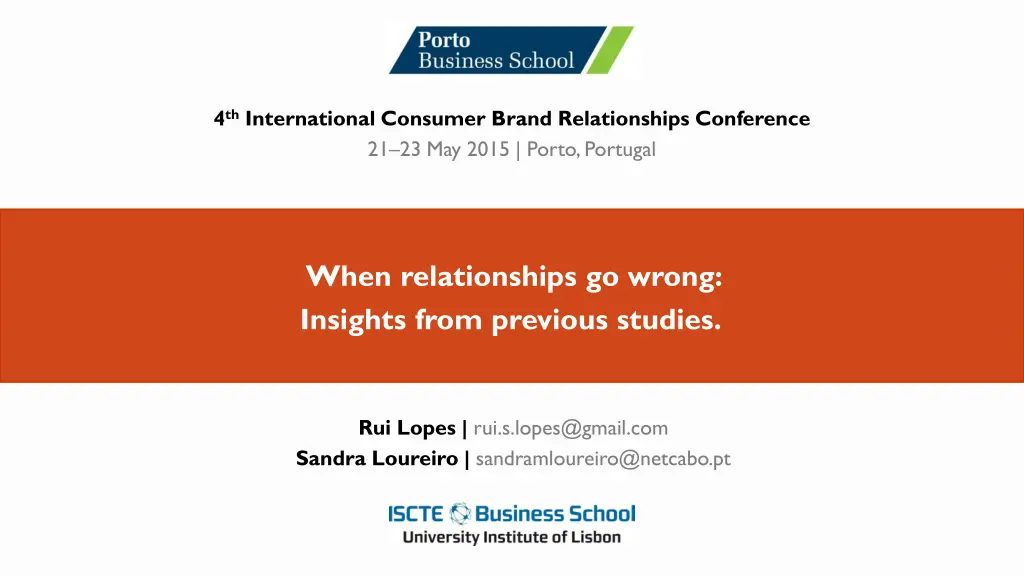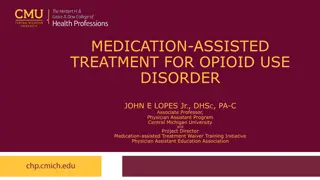
Insights into Negative Consumer-Brand Relationships at the 4th International Conference
Explore the uncharted territory of Negative Consumer-Brand Relationships (NCBR) through a systematic literature review and qualitative analysis at the 4th International Consumer Brand Relationships Conference in Porto, Portugal. This research aims to contribute a fresh perspective to brand management by delving into the complexities of NCBR and providing valuable insights for academics and managers alike.
Download Presentation

Please find below an Image/Link to download the presentation.
The content on the website is provided AS IS for your information and personal use only. It may not be sold, licensed, or shared on other websites without obtaining consent from the author. If you encounter any issues during the download, it is possible that the publisher has removed the file from their server.
You are allowed to download the files provided on this website for personal or commercial use, subject to the condition that they are used lawfully. All files are the property of their respective owners.
The content on the website is provided AS IS for your information and personal use only. It may not be sold, licensed, or shared on other websites without obtaining consent from the author.
E N D
Presentation Transcript
4thInternational Consumer Brand Relationships Conference 21 23 May 2015 | Porto, Portugal When relationships go wrong: Insights from previous studies. Rui Lopes | rui.s.lopes@gmail.com Sandra Loureiro | sandramloureiro@netcabo.pt
Overview Introduction Purpose and Originality Methodology Descriptive Findings Thematic Findings Implications and Limitations 4th ICBRC | Porto, Portugal Rui Lopes | May 23 - 2015
Introduction The academia has much to offer regarding positive consumer-brand relationships perhaps without conscious awareness,our brand theories have adopted assumptions that are more aligned with a positive brand relationship worldview than a negative one. But beyond this, theoretically grounded advice for managing negative consumer-brand relationship is scarce (Fournier andAlvarez,2013,p 261) Major studies can be found in anti-consumption area mainly focusing on dissatisfaction with goods/services (Banister & Hogg, 2004; Oliver, 1980), boycotts (Klein, Smith & John, 2004; Kozinets & Handelman, 1998), consumer resistance (Cherrier, 2009; Hogg, 1998; Zavestoski, 2002) or brand antagonists and doppelg nger images (Giesler,2012;Thompson,Rindfleisch, & Arsel, 2006). Anti-consumption can also comprise topics such as brand avoidance (Lee, Motion & Conroy,2009) or consumer retaliation (Funches,Markley & Davis,2009). 4th ICBRC | Porto, Portugal Rui Lopes | May 23 - 2015
Purpose Why this research topic? Existing theories assumptions aligned with a positive brand relationship Negative consumer brand relationships Emerging interest Too fragmented, superficial and limited mainly on these topics. Negative Consumer Brand Relationships NCBR o Emerging concept that has not been yet explored in the literature. o Needs to be conceptualized from the ground up, built on a deep understanding of how consumers experience it. 4th ICBRC | Porto, Portugal Rui Lopes | May 23 - 2015
Originality Aims Explore how NCBR is characterized even before consumption. Contribute with an original approach into the branding literature. Break new ground for a scale development regarding NCBR. Help managers to take more efficient decisions in brand management. Main objective o Conduct a systematic literature review to capture the main terms and construct employed in several previous studies to express negative relationships. 4th ICBRC | Porto, Portugal Rui Lopes | May 23 - 2015
Methodology Systematic literature review Exploratory qualitative analysis At this state of research, where the theme is merely blooming, the aim of using this method is to explore the topic, the methodology, as well as other relevant aspects of the research and, moreover,it will highlight the need for continuing research into its conceptualization (Cook,1997). o Determine the evolution of this current research issue over recent years and improve our understanding of this subject. Three stage procedure (Tranfield et al.,2003) 4th ICBRC | Porto, Portugal Rui Lopes | May 23 - 2015
Methodology 1. o In order to obtain a significant sample of articles, we focused in the most relevant scientific journals within the period 2009 2014,that assessed NCBR. Planning 2.Conducting o From a total of 207 identified studies,93 articles have been retained. o Titles,abstracts,meticulous examination,references,additional papers included. o A developed data extraction form was used and the processed documented. o Elements extracted:General details; features of the study; key results. 3.Conceptualization i. a descriptive analysis to provide an evidence base of the alignment issues; ii. a thematic analysis to identify key themes,their commonalities and differences. Globally, a thematic analysis involves the creation and use of codes to translate theoretical concepts into themes and can be data driven or theory driven (Boyatzis,1998;Thomas & Harden,2008). 4th ICBRC | Porto, Portugal Rui Lopes | May 23 - 2015
Descriptive Findings Publication Activity Journals o A total of 21 journals published on NCBR. o 6 journals issued 72% of the retrieved articles. o Highest number of publications per Journal: Journal of Business Research (29%), Journal of Consumer Behaviour & Journal of Consumer Psychology (11% each) Special Issues (Major contribution to the field). o Journal of Consumer Research, which focused on anti-consumption (2009). o Provided 18% articles that highly contributed to the advancement of academics knowledge on anti-consumption and NCBR. Dates o 82% of the articles were published between 2009 and 2014 2009 shows the highest number of articles - 23%; 2013 with 16% of the articles. 4th ICBRC | Porto, Portugal Rui Lopes | May 23 - 2015
Descriptive Findings Academic Contributions Authors o A total of 158 authors contributed to the field o 14% of them publishing, conjunctly or separately, more than one article. o Only a small margin of the articles was published by only 1 author (16%), followed by articles with 2 authors (43%) and 3 or more authors (41%). Country of Origin o 46% of the articles have only authors from the USA, followed by 9% with authors only from Australia, 7% of the articles were published only by UK authors and 6% from Canada - Anglo-Saxon countries. Cross-cultural publications o 25% of the total articles, wherein: 95% (USA - 55%; New Zealand - 7%; UK-14%) of them have at least one author from Anglo-Saxon countries. 4th ICBRC | Porto, Portugal Rui Lopes | May 23 - 2015
Thematic Findings Conflict attitude o Indicates confrontation against an object o It might reflect the competitive vs cooperative character of a brand relationship: o Revengeful associations, brand retaliation or boycott (Giesler, 2012; Thompson et al., 2006;Berry and Seiders,2008;Fisk et al.,2010) o Anti-consumption mainly regarding dissatisfaction with brands (Banister & Hogg, 2004;Oliver,1980). BrandAvoidance o A negative perception of relationship (Bartholomew & Horowitz,1991). o Has been associated with two causal variables (Park et al.,2013): Poor product performance and symbolic incongruence (Lee,et.al,2009). 4th ICBRC | Porto, Portugal Rui Lopes | May 23 - 2015
Thematic Findings Brand-self distance o Undesired self is a set of values with which people do not want to incorporate into his self-concept (Ogilvie,1987) o Consumers identify their social reference groups through what they choose to consume as well as what they choose not to consume. o The fact that a reference group is consuming a certain brand can influence other individuals to avoid the brand in order to not be associated with the mentioned group - dissociative reference groups (Hempel,2012). o Brand-self distance defines the perceived distance between one's self and the brand (Park et.al,2013). 4th ICBRC | Porto, Portugal Rui Lopes | May 23 - 2015
Thematic Findings Negative Perceived Emotions Emotion vs Relationship o The love emotion,which like all emotions,is short term (Rajeev,Ahuvia & Bagozzi,2012), o The love relationship can last for decades and involves numerous affective, cognitive, and behavioural experiences (Fournier 1998). We will consider that brand hate emotion refers to the emotional state of hate toward a brand that will influence the brand hate relationship. Negative emotions towards brands (Romani,Grapp & Dalli,2012) Scale comprising six distinct negative emotions towards brands (anger, sadness, worry, embarrassment, discontent,and dislike). We can expect that consumer brand relationships may become negative not only because of the way consumers feel about the brand, but also because of the way consumers feel about themselves when in the relationship with the brand (Roseman,Spindel,& Jose,1990). 4th ICBRC | Porto, Portugal Rui Lopes | May 23 - 2015
Thematic Findings Countercultural phenomena o Brands outside of the norm may serve as recognizable symbols of uniqueness (McGinnis & Gentry,2009). o Desire of uniqueness:Counter-conformity andAvoidance of similarity. If individuals fail to see a means of differentiating themselves from others in a socially appropriate manner,they may prefer acts that negatively distinguish them (Ziller,1964;Tian,Bearden & Hunter,2001). o Subculture whose values and norms of behaviour differ substantially from those of mainstream society (Roszak,1968). o Life cycle includes phases of: Rejection,growth,partial acceptance and absorption into the mainstream. 4th ICBRC | Porto, Portugal Rui Lopes | May 23 - 2015
Preliminary conceptual framework The preliminary conceptual framework is a tentative to explain the effects and relations between different types of variables which may support a more comprehensive model for the understanding the nature of NCBR. Conflict attitude Negative perceived emotions Brand-Self distance NCBR Countercultural phenomena 4th ICBRC | Porto, Portugal Rui Lopes | May 23 - 2015
Implications and Limitations Theoretical implications o The research evidence clearly assessed the existence of an established academic conversation regarding NCBR in meaningful ways; o The preliminary conceptual framework add useful insights for understanding the nature of NCBR allowing a further theorizing of the subject. Practical implications o Findings allow marketing managers to take more efficient decisions and avoid strategies that increment negative relationships. Limitations o The identified categories might have commonalities that need to be considered; o Other relevant themes must be included, such as sustainability issues ; o Future research should focus on testing other consumer s perspectives through qualitative and quantitative analyses to provide additional knowledge. 4th ICBRC | Porto, Portugal Rui Lopes | May 23 - 2015
4thInternational Consumer Brand Relationships Conference 21 23 May 2015 | Porto, Portugal Thank You Rui Lopes | rui.s.lopes@gmail.com Sandra Loureiro | sandramloureiro@netcabo.pt





